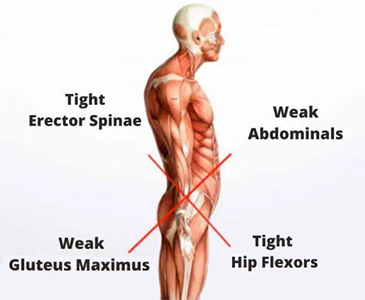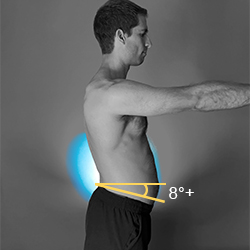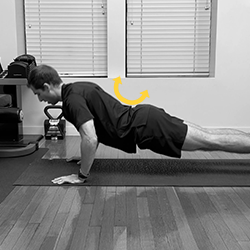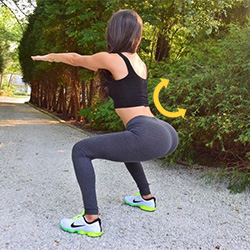I had low back pain like everyone else but fixed it with posture promoting exercises. My back hurt for years. I hated standing still. I’d strain a hamstring every year while running or playing sports. And my core didn’t look right in the mirror. Surprisingly, it all traced to a common issue. My hips. What causes poor hip and back posture? Can corrective exercises fix it? And what exercises can you do to prevent issues like mine? Well, let’s get into it!
Lower Crossed Syndrome
Two weeks ago, I detailed Doctor Vladimir Janda’s observation of Upper Crossed Syndrome (UCS). UCS is a postural and muscular misalignment issue of the head and shoulders. Janda frequently observed this same issue with our hips and lower back. He termed this lower crossed syndrome. A tight back and hip flexors are seen with weak glutes and abs [1]. This can cause hips to be excessively tilted forward. Some tilt is normal, but when it is beyond 8° it can cause issues [2].
For example, excessive tilt can inhibit the glutes. Our largest muscle is rendered useless. The hamstrings then take over the job of the glutes, called synergistic dominance. This added stress is likely what’s ended many of my running sessions and sporting events [3]. I thought my hamstrings were cursed. Besides decreasing athletic performance and increasing risk of injury, it affects our day-to-day health too. It is commonly suspected of causing low back pain [2]. Which I’ve had. And this poor posture can lead to compensation elsewhere. If I want to live to 100, I don’t want my knees, hips, or back failing at 70. I want to prevent the issues today.
Corrective Posture Routine
I scoured PubMed for answers but didn’t find a lot. A meta-analysis from 2019 concluded that both stretching and strengthening are relevant [4]. This is the approach I took. First, identify if you have lower crossed syndrome. Stand with normal posture in front of a mirror to identify an overarched lower back. Have someone take a video of you doing a pushup to see if hips are dropping to the floor. Or flip through your Instagram for the butt photos you posted.
I could see my issue in the mirror. My hips commonly tilted excessively with planks too. Unfortunately, no Instagram photos confirmed my findings. This led me to implementing specific stretches and exercises to correct the syndrome. While I don’t have a routine that I follow like with UCS, these are the most effective exercises I’ve added into my regular strength training program.
Hip Thrusts
These target the weak gluteus maximus muscles. If you don’t have a bench, glute bridges are a good substitute. For hip thrusts, I first sit close to the bench. I then place both shoulder blades on the bench and extend my arms out for balance. Then I raise my hips to the ceiling in a tabletop position for one repetition. I perform these to near exhaustion for three sets. Ideally, you’d progress this movement with a barbell for added resistance over weeks or months of progress. Without a barbell, one legged hip thrusts will work. I do three hard sets twice a week.
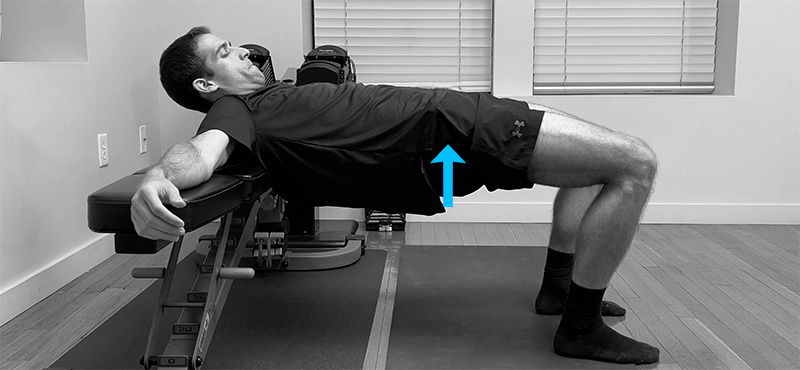
Glute Med Sequence
I found this gluteus medius sequence in Tim Ferriss’ book, Tools of Titans. I’ve done it every week since. It strengthens the smaller glute muscles. There are seven variations of the glute med exercises performed one after the other. I’ve worked my way up to ten repetitions of each for two sets, twice a week. Start by lying down on your side. Then you’ll use your top leg for the following sequence: 1) Up-Downs, 2) Front Kicks, 3) Back Kicks, 4) Full Kicks, 5) Clockwise Circles, 6) Counterclockwise Circles, and 7) Bicycles. Lately I’ve added Reverse Bicycles for a sequence of eight.
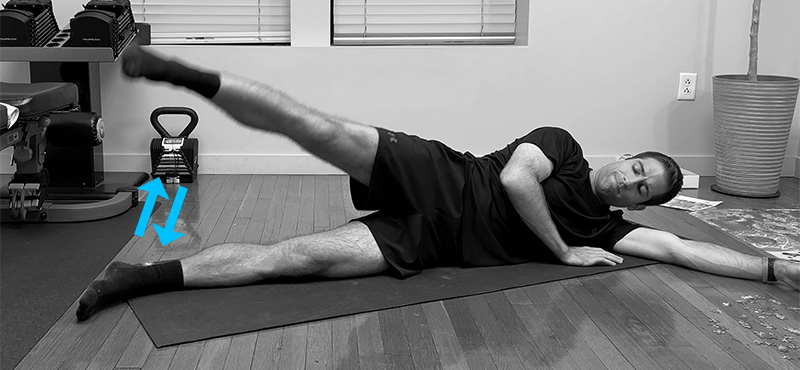
Dead Bugs
Strengthening the core is key for lower crossed syndrome. While I do many plank and rock climber variations, dead bugs might be best for this syndrome. Lie down on your back. Confirm your lower back is touching the floor. This marker is key for resisting pelvic tilt. Reach your arms and legs to the ceiling with a 90-degree bend in the knees. Finally, lower the opposite arm and opposite leg to the floor slowly and return to the starting position. Perform the movement with alternating arms and legs. I do twenty of these for two sets, twice a week. The dead bug can be progressed by reaching higher towards the ceiling, so your head and shoulder blades remain off the floor.
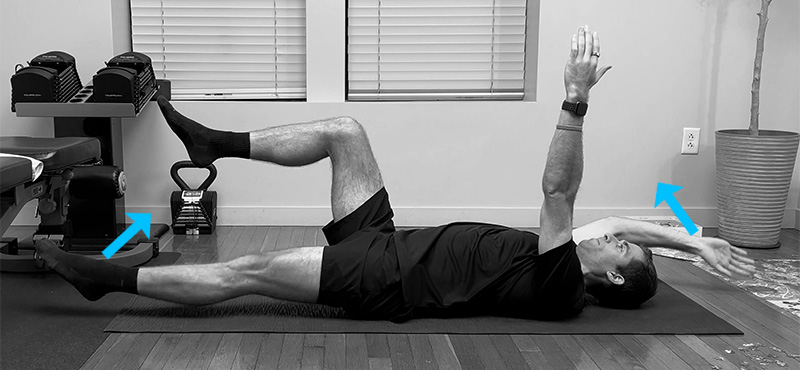
Relevant Notes
These are the three exercises I’ve found most effective. But stretching is helpful too. Frequently, I’ve sat in 90/90 stretches while eating dinner. 90/90’s are good for developing internal and external hip rotation. I also do kneeling hip flexor stretches as a part of my post-run stretching routine. By stacking these stretches onto my current habit routines, it feels less like one more thing to do. Incorporating healthy practices into everyday living is much easier.
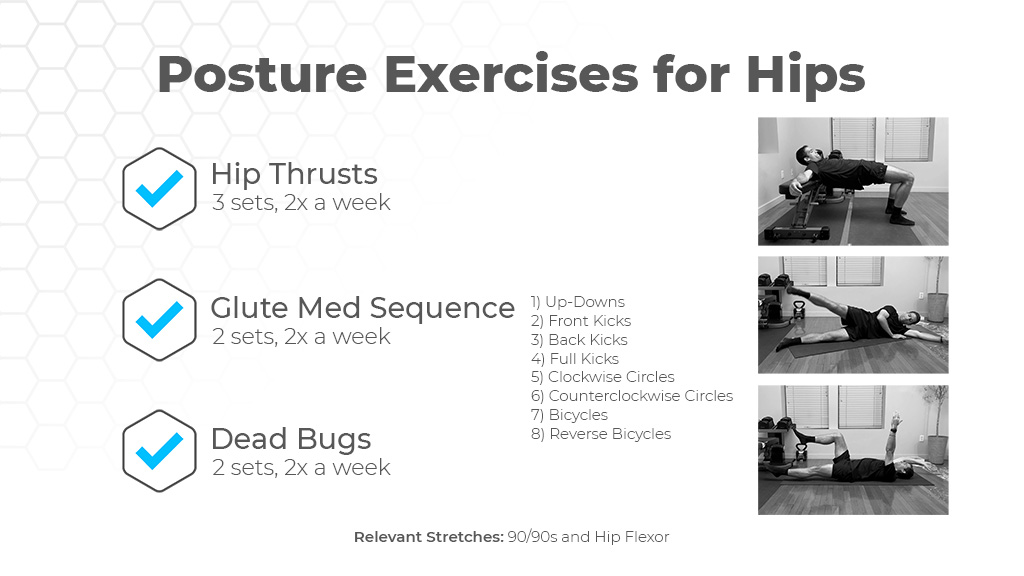
Final Thoughts
For years I didn’t understand my high frequency hamstring injuries or low back pain. Little did I know it was my hips. And if excessive anterior pelvic tilt didn’t cause me issues today, it’d likely lead to others down the road. Luckily, key exercises and stretches are correcting my hips and back. Hip thrusts, glute med exercises, and dead bugs are strengthening weak muscles. 90/90’s and hip flexor stretches are loosening tight muscles. Overall, my hips not only look normal in the mirror now, but I’m feeling healthier. This has been my first year running without a single injury. Let’s keep it going. These are my latest habits for health excellence.
Sources:
- [1] Lower Crossed Syndrome: Starting from The Center
- [2] Non-Surgical Interventions for Excessive Anterior Pelvic Tilt in Symptomatic and Non-Symptomatic Adults: A Systematic Review
- [3] Training-Induced Changes in Anterior Pelvic Tilt: Potential Implications for Hamstring Strain Injuries Management
- [4] Effects of Exercise Programs on Kyphosis and Lordosis Angle: A Systematic Review and Meta-Analysis

